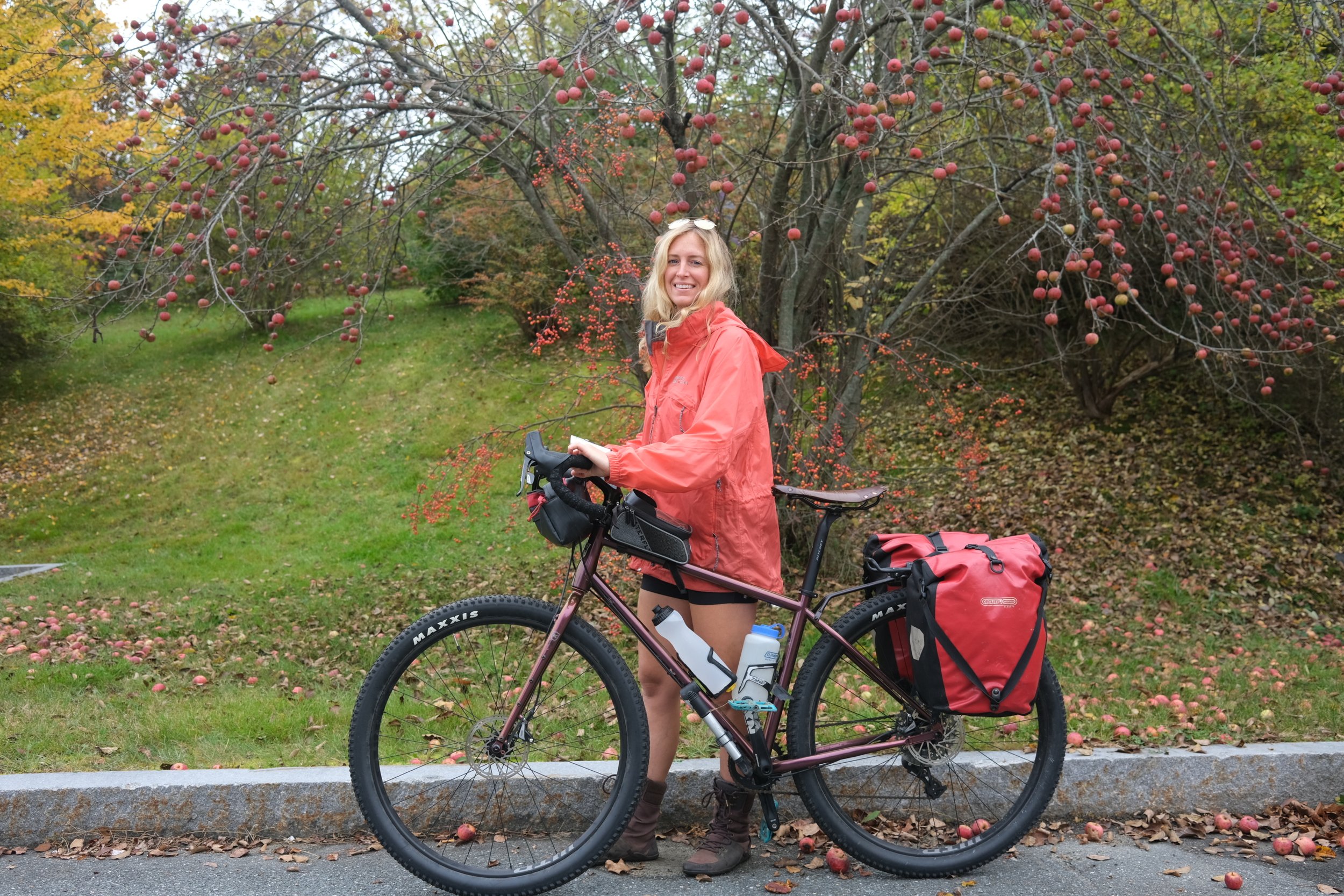Cycling Snacks: Make Your Own Dried Apples
In October I drove to the trailhead of the Cross New Hampshire Adventure Trail, unloaded my bike, and started packing my panniers. Something rolled under my foot, and I looked down at a tiny red apple. I was standing under a fully loaded apple tree!
The apples were small and mottled with brown spots. I picked one and bit into it. It was sweet and tart, and about a million times better than anything I could buy from the grocery store. This is the secret of apples: the best ones are usually small, ugly, and found in parking lots.
The Cross New Hampshire Adventure Trail winds 83 miles on pavement and dirt from the border of Vermont to Bethel, Maine. I spent the next three days biking to the end and back again. Along the way, I munched on dried fruits that I’d prepared at home. When I returned to the parking lot, I picked a bag of apples from the apple tree to take home and dry for my next journey.
Whenever I go for a bike ride, I bring a homemade Snack Attack Pack of dried fruits. Dried fruits are delicious, portable, and provide a quick dose of natural sugars. They’re easy to grab out of my handlebar bag to munch on while I ride; they’re also a great excuse to take a snack break in a lovely place.
Throughout the year, I harvest local fruits as they come into season and dry them in a food dehydrator. I store the fruits in glass jars in my cupboard. Before I go cycling, I just grab some fruits from each jar and put them in a Ziploc bag. This is a Snack Attack Pack!
This full circle of cycling and foraging makes me appreciate the magical connection between body, food, and motion. The fruit I eat becomes my body, my body pushes the pedals, the pedals spin the wheels, and we all go forward.
When you dehydrate a fruit, you remove the water from its cells. What you’re left with is a super condensed version of the original fruit. All the delicious flavors, tartness, sweetness, and aromas shrink into one tight little package, like a piece of candy.
Commercial-scale dried fruits will never taste the same as fruits you dry yourself at home. They’re usually doused with preservatives and sometimes other additives like coloring or anti-caking agents. Commercial-scale dried fruits are also often made from fruits that were bred for quantity, not flavor. When you dry local, flavorful fruits at home, you get a totally different product — you get a snack that tastes like candy but is actually good for you. I’m telling you, it’s a win.
In temperate climates, my favorite fruits to dehydrate are apples, pears, strawberries, and blueberries. In the tropics, I dry bananas, jackfruit, and pineapple. I’ve also tried autumn olives, wild grapes, blackberries, and cranberries. Lots of local and wild fruits make great dried snacks.
My mom volunteers at a local food pantry, and sometimes they have leftover boxes of bananas. My mom hates to see good food go to waste, so she takes the bananas door to door around her neighborhood, asking people if they want any. If she can’t hand them off to other people, she takes them back home to dehydrate. This means I’m often the lucky recipient of bags of dried bananas — another great addition to a Snack Attack Pack.
If you’re looking for an alternative to sugary, processed cycling snacks, just keep your eyes open for local fruits wherever you are. Or call my mom, who might have some extra bananas.
Dried Apples
Ingredients: Apples
Instructions:
Core the apples and cut them in thin slices or rounds. Lay them flat on the tray of a food dehydrator* and dehydrate at 135°F for 12 hours or until done.
Some people drizzle lemon juice over their apple slices to preserve the color. I’ve done this and it works. However, the difference is so minimal that I no longer bother.
For short-term storage, I dehydrate apples until they’re dry but still flexible. For longer-term storage, I dehydrate them until they’re crisp like apple chips. Fully dried, crisp apples can last a year or more in storage. Store dried apples in glass jars in a cool, dark, place.
*You can often find dehydrators at thrift stores or yard sales. I use a nine-tray Excalibur Dehydrator. In some climates, homemade solar dehydrators are also very functional. Other people use an oven turned to low.
Dried Apple Variations
Try sprinkling the sliced apples with spices before you dry them. The apples will reduce in volume as they dry, so a little spice goes a long way! Some good spice variations are:
Chile Apples
Cinnamon Apples
Apple Pie Apples (Cinnamon, Allspice, Nutmeg)
A version of this essay was first published at The Adventure Cycling Association on November 9, 2021.





